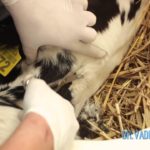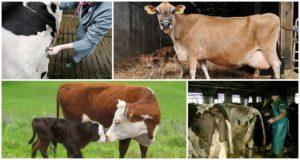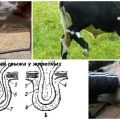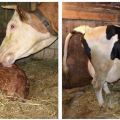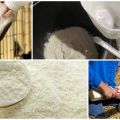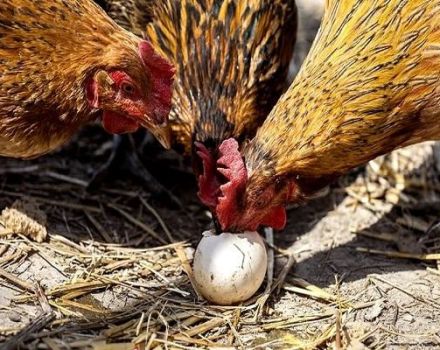Causes of umbilical sepsis in the calf, treatment and prevention of inflammation
Umbilical sepsis (omphalitis) is an infectious disease that affects newborn animals. Pathology develops as a result of pathogenic bacteria entering the tissue through the umbilical cord. If the calf has an inflamed navel, treatment should be done immediately. Otherwise, blood poisoning will occur, and the animal will die. Most often, the disease is detected in calves within the first ten days.
Why umbilical sepsis is dangerous
Chronic omphalitis does not pose a threat to the life of a newborn, but it significantly undermines the patient's health:
- Development of hematological diseases.
- Damage to the joints and lungs.
- The appearance of cardiovascular diseases, including low blood pressure, tachycardia, myocarditis, pericarditis.
- Toxic hepatitis.
- Respiratory failure.
- Indigestion. Prolonged diarrhea leads to dehydration and significant weight loss in the calf.
- Necrosis of tissues around the navel.
- The appearance of metastases in organs.
The acute form of the disease leads to the death of the animal in just a few days. Advanced chronic sepsis can cause the calf to become comatose.
Causes of occurrence
The disease most often occurs within the farm without any external influence. The most common causes of sepsis are:
- Unsanitary conditions in the premises where livestock are kept. Keeping clean is especially important during calving. Newborn calves are the most susceptible to infection. If the room is dirty, pathogens instantly enter the open wound and provoke sepsis. Usually the source of infection is dirty bedding, dishes, unwashed hands of staff.
- The introduction of pathogenic microflora at the time of the introduction of drugs into the navel to revive the fetus.
- Thinness of the skin of the fetus, caused by malformations or prematurity.
- Decreased immunity due to improper feeding of the cow.
- Immaturity of the vessels of the umbilical cord.
Disease symptoms
At the initial stage, signs of inflammation of the umbilical cord develop very quickly. Approximately 10 hours after calving, the following manifestations are observed:
- thickening of the umbilical cord;
- soreness of the navel;
- a slight increase in body temperature;
- stool problems (constipation);
- there is no regeneration of the umbilical wound;
- soon you can see that the navel has festered (phlegmons appear - deep abscesses);
- the calf refuses to drink breast milk;
- weight gain stops;
- purulent rashes appear on the skin;
- skin hemorrhages are observed;
- dyspnea;
- convulsions.

Diagnostic rules
Monitoring the condition of animals during the calving period allows you to collect the necessary clinical data for the diagnosis of the disease. To accurately identify pathology, diagnostic tests are used:
- analysis of changes in the umbilical cord;
- analysis of changes in the surrounding tissues and the entire skin (the presence of abscesses and other negative changes);
- bacterial culture;
- a blood test for pathogenic microorganisms;
- checking the frequency and rhythm of breathing.
It is important to distinguish omphalitis from other similar diseases. The latter should include:
- dysentery;
- dyspepsia;
- typhoid fever;
- tuberculosis;
- brucellosis;
- lymphogranulomatosis.
How to treat umbilical inflammation in calves
Therapy for umbilical sepsis is carried out according to one of the following treatment regimens:
- Intramuscular administration of the antibiotic for 3-6 days. On the first day, use "Selendant", on the first and fifth days - "Trivit", on the first and fourth - a solution of novocaine (intraperitoneally).
- On the first and second day, an antibiotic is injected - one part at the base of the umbilical cord, the other intramuscularly. For 3-6 days, antibiotics are injected intramuscularly, then they act according to the first scheme.
- Within 3-6 days, the antibiotic is injected intramuscularly. On the first day "Selendant" is injected. "Trivit" is used on the first and fifth days, and on the first, second and third days, injections of novocaine solution are made (inside the abdominal wall around the problem area, the dose is divided into parts and injected into the navel from 3-4 sides). On the first and fourth days, the same drug is injected intraperitoneally into the area of the right hungry fossa.
Important notes:
- before using an antibiotic, it is important to check the sensitivity of pathogenic bacteria to this drug;
- when injecting gobies, you can easily touch the bladder, which is highly undesirable;
- before the introduction of the drug, the solution must be warmed up.
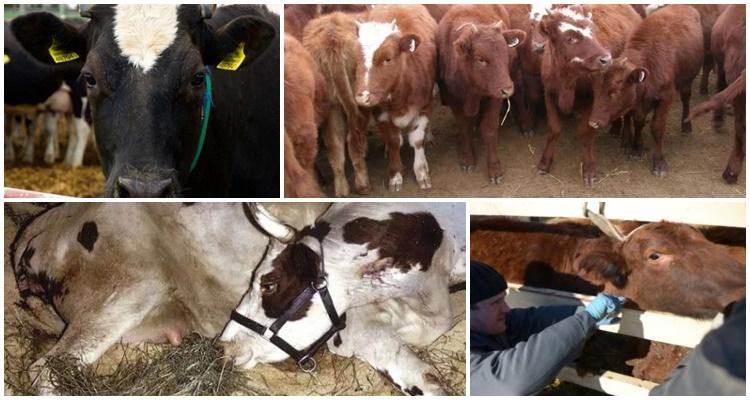
Prevention
The main actions to prevent the development of umbilical sepsis in calves are:
- Delivery under sterile conditions, in compliance with all hygiene rules. The permissible number of microbes per cubic meter is no more than 50 thousand.
- After calving, newborns should be wiped with a clean, dry cloth.
- Cut the umbilical cord if it did not break off on its own. The operation is carried out with a processed tool. In this case, 7-8 centimeters of fabric are left.
- Then it is necessary to remove wartons jelly and treat the area with antiseptics (iodine, ethyl alcohol, hydrogen peroxide, brilliant green, chlorhexidine or dioxidine solution).
- Keeping the area where the animals are kept clean.
If the calves show signs of umbilical sepsis, the sick animal needs urgent veterinary care. The acute form of omphalitis lasts for several days, so there is very little time left to save the calf. In some cases, in the absence of treatment, the pathology turns into a chronic, but no less dangerous form. Compliance with preventive measures will help prevent the development of pathology.

